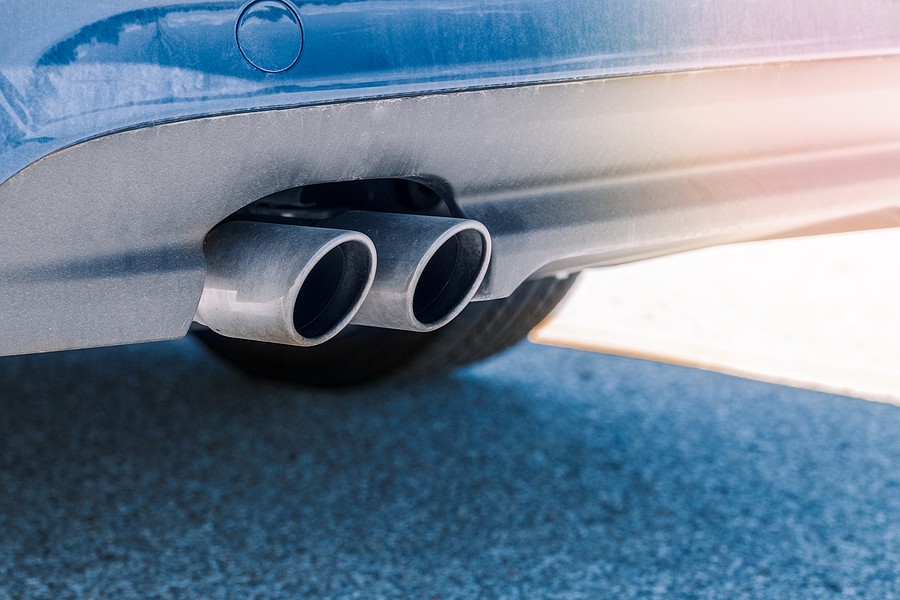Exhaust leaks should never be ignored. In rare instances, they can only cause an irritating noise while driving, but they can also be dangerous when it is closed to the fuel or other flammable elements on your vehicle, or if it is leaking into the car’s cabin. Exhaust leaks that are big enough can change the back pressure of a car and will eventually the performance of your car. This is why it is important to know how to find an exhaust leak. The good news is, there are quick and easy ways to check leaks, and determine where the leak is coming from.
The exhaust system in your car is there for a relatively simple function but there are times that it accomplishes it in a complex manner. The main goal of the exhaust system in a car is to direct the gases coming from your combustion chamber to a safe place. The safest place is somewhere outside of your car, far from you and any openings like windows in your car. This typically means somewhere beneath the rear bumper.
The secondary purpose of the exhaust system is to muffle the sound of the explosions that are occurring inside the engine and the sound of high velocity gases getting out of the tailpipe. It becomes complicated when you look at the route that the exhaust has to take. Bear in mind that it can get very hot. Also, the engine moves around a bit and vibrates while driving depending on what you are doing: downshifting, just idling or accelerating heavily. This is why your exhaust needs to safely carry dangerous fumes in a fast and quiet manner to the back of the vehicle without getting anything too hot. The exhaust system uses different manifolds, pipes, heat shields, joints, mufflers, flexible unions and rubber hangers to accomplish this.
Where is my exhaust leaking from?
Determine the source of the problem. Exhaust pipes can get extremely hot so the best thing to do is to let the vehicle cool down first when attempting to isolate a leak. Do not touch the exhaust system when you have been driving your car under operating temp. Follow this guide to know how to find an exhaust leak:
- Do a visual inspection. Open the hood and check the exhaust manifold (if you can see it). Most of the time it is covered with a heat shield. The leak or leaks can be found in 3 areas of an exhaust manifold. It can leak on the manifold itself when it cracks. It can also leak in the mounting surface (gasket) where it joins the engine, and the gasket where the downpipe is attached.
- Listen carefully near the manifold’s top. Check for a sharp in-rhythm ticking sound. A leak usually sounds like this. There are times that an exhaust leak at the manifold can be confused with an engine knock. But typically, it’s an exhaust leak. If the ticking sound comes from lower down the engine, chances are it’s the flange gasket connecting the manifold to the catalytic converter or the down pipe. It is highly recommended to put the car on the ramps.
Remember: Check only when the car is cold. Listen and check where the exhaust pipe has connections. You can carefully feel the air around the pipe connection using your hand since the car is cold. But do not touch. You will feel the air pulsing out of the area of where the leak is.
- There are many common exhaust components that can fail under the car. Many cars have a flex-pipe in the exhaust system. Such a pipe has a flexible metal interior like an accordion, which has a woven, stainless steel fabric around it. This flex-pipe can fail and leak over time. A bad flex-pipe is easy to detect and produces a good deal of exhaust noise.
- Flexible flange joints are another common problem area. Most flexible exhaust joints have a spring flange with a big “donut” gasket which enables flexing as the vehicle moves. Oftentimes, these flexible joints go bad, and it’s usually the donut gasket that deteriorates. Although a non-flexible joint also fails, it is not as common as flexible joints.
- The muffler and catalytic converter are also common failure areas. Inspect if there are any holes or parts where the muffler has come apart or rusted through. A catalytic converter usually goes bad due to the breaking apart of its honeycomb element inside. Then it starts to rattle. Resonators, which are basically a secondary muffler, can also rust, break open and fail.
- During inspection, pay close attention to the exhaust pipe and check the pipe if there is a good amount of rust, or see if there are any broken rubber hangers. Majority of OEM exhaust systems that are made in the last 15 years are stainless steel, but some are not. When you see a considerable amount of rust in particular spots on the pipe, these spots may go bad soon. Using a pair of large pliers, gently squeeze those spots. When the pipe compresses or flexes, it is very thin and requires attention.
Remember: A common sign of an exhaust leak on any area is black soot. When you see it on any area of the pipe, muffler, on any connection of the pipe, or other components, there is a leak.
How can I tell if I have an exhaust leak?
The exhaust system is there for your car’s safety. If it gets damaged or if it leaks, the dangerous fumes from the exhaust system of the car can leak into the passenger cabin. This poses a risk of the driver and the passengers inhaling poisonous gases. Visit an auto repair shop once you suspect a leak in the exhaust system of your car. You can actually manage to do the exhaust leak repair once you know what to look for. Here are common signs and symptoms that you have an exhaust leak:
- Decreased Fuel Efficiency: The efficiency of your car could decrease by 3 to 4 mpg when there is an exhaust leak near the manifold. It happens since the leak bypasses the sensors that detect the incoming and outgoing oxygen. Consequently, excessive amounts of fuel are burned. Make sure to repair any exhaust system leaks as soon as possible to save on money and gas.
- Ticking or Raspy Noise and Vibrations: If you start noticing a tapping, ticking or raspy noise under your car or in front of you in the engine compartment when accelerating, you may have a leak on your exhaust pipe. Even minor leaks can produce noise, or even vibrations, because fumes can escape at high velocity. Major leaks will cause worse vibrations that can be felt even on the floorboards and the steering wheel. It also becomes worse when accelerating harder.
- Very Strong Odor: Carbon monoxide is the only odorless among exhaust fumes. You will notice a very strong odor in the air when you have a leak on your exhaust manifold. If the strong smell persists, then it is definitely dangerous exhaust emissions that should not be inhaled for very long. Thus it is necessary to take your car to an auto repair shop immediately and have them inspect the problem and fix it. Be sure to have your windows open when you drive. You cannot take any chances with carbon monoxide as it can be lethal.
- Increasing Loud Noise: When you start your car and hear a noise that gets louder coming from around the engine, it is a sign that you have an exhaust manifold gasket leak. The gasket is found in between the engine block and the piping of the exhaust manifold. Like the piping, the gasket gets heated and cooled constantly.
How do you fix an exhaust leak at home?
When you find out that there’s an exhaust leak from the manifold or the joints, change the failed gasket to seal the leaks. All joints that are made to be separated on the exhaust system have a replaceable gasket. Do note that the nuts or bolts that hold these joints together can be considerably rusty which can make it difficult to remove them. What you can do is to pre-soak any bolts in penetrating oil, ideally a day before you plan on removing them. Also remember that exhaust bolts can tend to break, so when you loosen them and you start to feel heavy resistance, shift to tightening the bolt by a quarter turn, spritz some penetrating oil, and try loosening them again. Continue the process slowly back and forth if you experience any resistance.
When repairing any leak at a joint, particularly a flexible joint that has a donut gasket, be sure that the area and sealing surfaces are completely clean. Old gasket material is usually hard to remove, and will require a good scraper or wire brush to have it removed entirely. Use a wire brush that is connected to a drill when taking off gasket material in a ball/cup style flex flange. This works well to smoothen and clean the area.
In case you have to replace a resonator, a muffler, or catalytic converter, some of these items can be bolted with a flange or clamped into place, but usually, they are welded into place. Oftentimes, even clamped items can be hard to be taken off and needed to be cut out with a saw to accomplish the task. But if you are in doubt, it is better to have it done by a mechanic in an auto repair shop.
Another thing you can do to fix exhaust leaks temporarily is to use epoxy bonds and tapes. But remember to clean and smoothen the leaking surfaces before applying the adhesive. An aluminum patch will harden the epoxy bonds. Once you are finished, wrap the area using an exhaust tape. Bear in mind that several of these fixes only last some time and are all meant to be emergency repairs. You will have to replace the component eventually.
If you suspect you have an exhaust system leak, make sure to have it checked right away for your vehicle’s safety and your health. Fumes from the exhaust system are dangerous when they enter your passenger’s cabin. It can be dangerous to your health.
Can you drive with an exhaust leak?
Although it is possible to drive with an exhaust like, it is not advisable to continue driving your car knowing it has an exhaust leak. Poor gas mileage, noises, and vibrations might be tolerable and just plain annoying, but you cannot take chances on carbon monoxide. You may think that you are safe from noxious exhaust fumes inside your car’s cabin, when in fact the interior is not airtight so carbon monoxide can slowly begin to seep in but it has a difficult time getting out. You may suffer from headaches, dizziness or fatigue with some exposure to exhaust fumes. Dizziness can easily cause an accident while prolonged exposure to carbon monoxide can even cause death. When you are experiencing any of the symptoms indicated previously especially when you smell exhaust fumes, roll your windows down and take your car to a muffler or auto repair shop.
Will an exhaust leak cause a check engine light?
Yes, it may. An exhaust leak can cause the check engine light to illuminate and also because of the fact that it can result in poor readings from the oxygen sensor. As the name implies, the oxygen sensor monitors exhaust for oxygen levels. A leak in the exhaust can cause high levels of oxygen present in the fumes which would result in the sensor increasing fuel consumption.
Conclusion:
When there’s any indication of an exhaust leak you should have it checked out right away. You should not wait for all the symptoms to appear before taking action. If you know how to find an exhaust leak, you can also do a temporary fix. Remember to have the windows rolled down when you drive your car with an exhaust leak to a repair shop.



